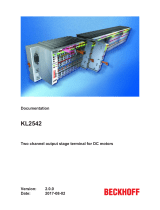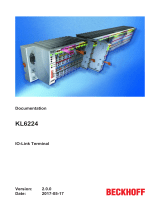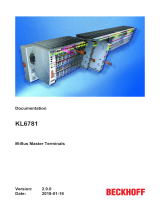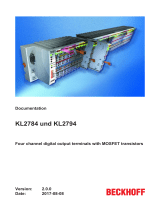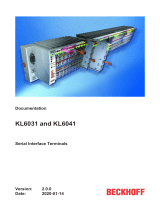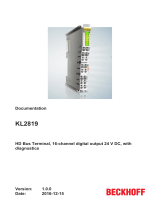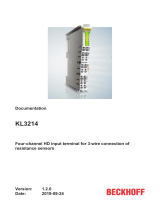Page is loading ...

Documentation
KL5151/KS5151, KL5152/KS5152
Incremental Encoder Terminals
2.0.0
2016-03-15
Version:
Date:


Product overview: incremental encoder interface
1 Product overview: incremental encoder interface
KL5151-0000 [}8]: single-channel incremental encoder terminal
KL5151-0021 [}9]: single-channel incremental encoder terminal with comparator output
KL5151-0050 [}10]: two-channel incremental encoder terminal
KL5152-0000 [}10]: two-channel incremental encoder terminal
KL5151/KS5151, KL5152/KS5152 3Version: 2.0.0

Table of contents
Table of contents
1 Product overview: incremental encoder interface .................................................................................3
2 Foreword ....................................................................................................................................................5
2.1 Notes on the documentation............................................................................................................. 5
2.2 Safety instructions ............................................................................................................................ 6
2.3 Documentation issue status.............................................................................................................. 7
3 Product overview.......................................................................................................................................8
3.1 KL5151-0000 - Introduction .............................................................................................................. 8
3.2 KL5151-0021 - Introduction .............................................................................................................. 9
3.3 KL5152-0000 (KL5151-0050) - Introduction ................................................................................... 10
3.4 Technical data ................................................................................................................................ 11
4 Mounting and connection.......................................................................................................................12
4.1 Installation on mounting rails .......................................................................................................... 12
4.2 Connection system ......................................................................................................................... 14
4.3 KL5151-0000 - Connection............................................................................................................. 18
4.4 KL5151-0021 - Connection............................................................................................................. 19
4.5 KL5152-0000 (KL5151-0050) - Connection.................................................................................... 20
4.6 ATEX - Special conditions .............................................................................................................. 21
4.7 ATEX Documentation ..................................................................................................................... 22
5 Configuration software KS2000 .............................................................................................................23
5.1 KS2000 - Introduction ..................................................................................................................... 23
5.2 Parameterization with KS2000 ....................................................................................................... 25
5.3 Settings........................................................................................................................................... 26
6 Access from the user program ..............................................................................................................28
6.1 KL5151-0000 .................................................................................................................................. 28
6.1.1 Process image ....................................................................................................................28
6.1.2 Control and status bytes .....................................................................................................29
6.1.3 Mapping ..............................................................................................................................31
6.2 KL5151-0021 .................................................................................................................................. 33
6.2.1 Process image ....................................................................................................................33
6.2.2 Control and status bytes .....................................................................................................33
6.3 KL5152-0000 (KL5150-0050) ......................................................................................................... 35
6.3.1 Process image ....................................................................................................................35
6.3.2 Control and status bytes .....................................................................................................38
6.3.3 Mapping ..............................................................................................................................40
6.4 Register .......................................................................................................................................... 44
6.4.1 Register overview ...............................................................................................................44
6.4.2 Register description ............................................................................................................45
6.4.3 Examples of Register Communication................................................................................48
7 Appendix ..................................................................................................................................................51
7.1 Support and Service ....................................................................................................................... 51
KL5151/KS5151, KL5152/KS51524 Version: 2.0.0

Foreword
2 Foreword
2.1 Notes on the documentation
Intended audience
This description is only intended for the use of trained specialists in control and automation engineering who
are familiar with the applicable national standards.
It is essential that the following notes and explanations are followed when installing and commissioning
these components.
The responsible staff must ensure that the application or use of the products described satisfy all the
requirements for safety, including all the relevant laws, regulations, guidelines and standards.
Disclaimer
The documentation has been prepared with care. The products described are, however, constantly under
development. For that reason the documentation is not in every case checked for consistency with
performance data, standards or other characteristics. In the event that it contains technical or editorial errors,
we retain the right to make alterations at any time and without warning. No claims for the modification of
products that have already been supplied may be made on the basis of the data, diagrams and descriptions
in this documentation.
Trademarks
Beckhoff
®
, TwinCAT
®
, EtherCAT
®
, Safety over EtherCAT
®
, TwinSAFE
®
, XFC
®
and XTS
®
are registered
trademarks of and licensed by Beckhoff Automation GmbH & Co. KG.
Other designations used in this publication may be trademarks whose use by third parties for their own
purposes could violate the rights of the owners.
Patent Pending
The EtherCAT Technology is covered, including but not limited to the following patent applications and
patents: EP1590927, EP1789857, DE102004044764, DE102007017835 with corresponding applications or
registrations in various other countries.
The TwinCAT Technology is covered, including but not limited to the following patent applications and
patents: EP0851348, US6167425 with corresponding applications or registrations in various other countries.
EtherCAT
®
is registered trademark and patented technology, licensed by Beckhoff Automation GmbH,
Germany
Copyright
© Beckhoff Automation GmbH & Co. KG, Germany.
The reproduction, distribution and utilization of this document as well as the communication of its contents to
others without express authorization are prohibited.
Offenders will be held liable for the payment of damages. All rights reserved in the event of the grant of a
patent, utility model or design.
KL5151/KS5151, KL5152/KS5152 5Version: 2.0.0

Foreword
2.2 Safety instructions
Safety regulations
Please note the following safety instructions and explanations!
Product-specific safety instructions can be found on following pages or in the areas mounting, wiring,
commissioning etc.
Exclusion of liability
All the components are supplied in particular hardware and software configurations appropriate for the
application. Modifications to hardware or software configurations other than those described in the
documentation are not permitted, and nullify the liability of Beckhoff Automation GmbH & Co. KG.
Personnel qualification
This description is only intended for trained specialists in control, automation and drive engineering who are
familiar with the applicable national standards.
Description of symbols
In this documentation the following symbols are used with an accompanying safety instruction or note. The
safety instructions must be read carefully and followed without fail!
DANGER
Serious risk of injury!
Failure to follow the safety instructions associated with this symbol directly endangers the
life and health of persons.
WARNING
Risk of injury!
Failure to follow the safety instructions associated with this symbol endangers the life and
health of persons.
CAUTION
Personal injuries!
Failure to follow the safety instructions associated with this symbol can lead to injuries to
persons.
Attention
Damage to the environment or devices
Failure to follow the instructions associated with this symbol can lead to damage to the en-
vironment or equipment.
Note
Tip or pointer
This symbol indicates information that contributes to better understanding.
KL5151/KS5151, KL5152/KS51526 Version: 2.0.0

Foreword
2.3 Documentation issue status
Version Comment
2.0.0 • Migration
• Update revision status
1.3.0 • Technical data updated
• ATEX notes added
• Extended temperature range for KL5151-0000
• Description of control and status bytes of the KL5151-0021 corrected
1.2.0 • Introduction updated
• Description of the parameterization of the KL5151 by means of KS2000
configuration software updated.
• Register description updated
• Mounting description expanded
• KL5151-0021 added
• KL5151-0050 now available as KL5152-0000
1.1.0 • Description of the process images expanded
• Mapping tables added
1.0 • KL5151-0050 added
• Description of the parameterization of the KL5151 by means of KS2000
configuration software added.
0.1 Preliminary version (KL5151-0000 only)
Firmware and hardware versions
Documentation
Version
KL5151-0000 KL5151-0021 KL5152-0000 (KL5151-0050)
Firmware Hardware Firmware Hardware Firmware Hardware
2.0.0 4E 09 14 08 4E 09
1.3.0 4C 07 13 07 4C 07
1.2.0 4C 07 13 07 4C 07
1.1.0 3A 02 - - 3A 02
1.0 3A 02 3A 02
0.1 3A 00 - -
The firmware and hardware versions (delivery state) can be taken from the serial number printed on the side
of the terminal.
Syntax of the serial number
Structure of the serial number: WWYYFFHH
WW - week of production (calendar week)
YY - year of production
FF - firmware version
HH - hardware version
Example with ser. no.: 35 04 3A 02:
35 - week of production 35
04 - year of production 2004
3A - firmware version 3A
02 - hardware version 02
KL5151/KS5151, KL5152/KS5152 7Version: 2.0.0

Product overview
3 Product overview
3.1 KL5151-0000 - Introduction
Fig.1: KL5151
The KL5151-0000 Bus Terminal is an interface with 24 V inputs for the direct connection of incremental
encoders. A 32 bit counter with a quadrature decoder and a 32 bit latch for the zero pulse can be read, set or
enabled.
The KL5151-0000 Bus Terminal can also be used as a 32-bit up/down counter.
Table1: LED indicators
LED Function
Ch. A Lights up when a signal is present at input A.
Ch. B Lights up when a signal is present at input B.
Ch. C Lights up when a signal is present at input C (zero input).
Gate / Latch Lights up when a signal is present at the gate/latch input.
KL5151/KS5151, KL5152/KS51528 Version: 2.0.0

Product overview
3.2 KL5151-0021 - Introduction
Fig.2: KL5151-0021
The KL5151-0021 Bus Terminal is an interface with 24 V inputs for the direct connection of incremental
encoders. A 32 bit counter with a quadrature decoder and a 32 bit latch for the zero pulse can be read, set or
enabled.
The KL5151-0021 Bus Terminal has an additional comparator output.
Table2: LED indicators
LED Function
Ch. A Lights up when a signal is present at input A.
Output Lights up when the comparator output is switched on.
Ch. B Lights up when a signal is present at input B.
Ch. C Lights up when a signal is present at input C (zero input).
Gate / Latch Lights up when a signal is present at the gate/latch input.
Operation
Referencing
Enter the reference value for referencing via the output double word DataOUT1 [}33] and set bits CB1.0
[}33] (EnLatchC) and CB1.2 [}33] (SetCnt) in the control byte. The reference value is now adopted by the
counter on a rising edge at input C.
Measuring the workpiece
At the beginning of the measurement the filter value is preset in the filter register R0 [}45].
Then set the release bit CB1.1 [}33] (EnMeas) in the control byte. If a plate has been successfully
measured, the terminal sets bit SB1.1 [}34] (MeasDone) in the status byte.
The measurement begins on an appropriate edge. If the level already exists, only the position of the end of
the board is determined. The start of the measurement is then taken as the start of the board.
Post-forming sawing
The output has a rise time of 10 µs and a 40 µs delay due to the optocoupler.
KL5151/KS5151, KL5152/KS5152 9Version: 2.0.0

Product overview
3.3 KL5152-0000 (KL5151-0050) - Introduction
Fig.3: KL5151-0050
The KL5152-0000 (KL5151-0050) Bus Terminal is an interface with 24 V inputs for the direct connection of
two incremental encoders. The terminal can optionally be used as a single-channel or two-channel device.
Table3: LED indicators
Signal LED Function Encoder
Ch. A1 Lights up when a signal is present at input A1. 1
Ch. B1 Lights up when a signal is present at input B1.
Ch. A2 Lights up when a signal is present at input A2. 2
Ch. B2 Lights up when a signal is present at input B2.
KL5151/KS5151, KL5152/KS515210 Version: 2.0.0

Product overview
3.4 Technical data
Technical data KL5151-0000 KL5151-0021 KL5152-0000 (KL5151-0050)
Sensor inputs (channels) 1 2
Encoder connection A, B, C, Gate, 24 V Channel 1: A1, B1
Channel 2: A2, B2
Encoder operating voltage 24 V
DC
Counter 1 x 32 bit binary 2 x 32 bit binary
Limit frequency 100 kHz
Quadrature decoder 4-fold evaluation
Commands read, set, latching,
Compare function for setting the output (KL5151-0021 only)
Supply voltage 24V
DC
(-15%/+20%)
Comparator output 0 1 0
Current consumption from
the power contacts
Typically 100 mA (without sensor load current)
Bit width in the K-bus I/O 4 x 16 bit user data, 1 x 8 bit control/status
Bit width in the input
process image
2 data words,
1 status byte
compact [}36] complete [}36]
4 data words 4 data words,
2 status bytes
Bit width in the output
process image
2 data words,
1 control byte
2 data words,
2 control bytes,
2 filler bytes
4 data words,
2 control bytes
Supply voltage for internal
E-bus circuit
via the K-bus
Current consumption from
K-bus
typically 50 mA
Weight approx. 50 g
Dimensions (W x H x D) approx. 15 mm x 100 mm x 70 mm
Mountin [}12]g
on 35 mm mounting rail conforms to EN 60715
Pluggable wiring [}14]
at all KSxxxx series terminals
Permissible ambient
temperature range during
operation
-25°C ... +60°C*
0°C ... +55°C (UL)
0°C ... +55°C (ATEX
[}21])
0°C ... + 55°C
Permissible ambient
temperature range during
storage
-40°C ... + 85°C -25°C ... + 85°C
Permissible relative
humidity
95%, no condensation
Vibration/shock resistance conforms to EN 60068-2-6 / EN 60068-2-27
EMC immunity/emission conforms to EN 61000-6-2 / EN 61000-6-4
Protection class IP20
Installation position variable
Approval
CE, cULus, ATEX [}21]
*) -25°C ... +60°C (extended temperature range)
0°C ... +55°C (according to cULus for Canada and the USA)
0°C ... +55°C (according to ATEX, see special conditions)
KL5151/KS5151, KL5152/KS5152 11Version: 2.0.0

Mounting and connection
4 Mounting and connection
4.1 Installation on mounting rails
WARNING
Risk of electric shock and damage of device!
Bring the bus terminal system into a safe, powered down state before starting installation,
disassembly or wiring of the Bus Terminals!
Assembly
Fig.4: Attaching on mounting rail
The Bus Coupler and Bus Terminals are attached to commercially available 35mm mounting rails (DIN rails
according to EN60715) by applying slight pressure:
1. First attach the Fieldbus Coupler to the mounting rail.
2. The Bus Terminals are now attached on the right-hand side of the Fieldbus Coupler. Join the
components with tongue and groove and push the terminals against the mounting rail, until the lock
clicks onto the mounting rail.
If the Terminals are clipped onto the mounting rail first and then pushed together without tongue and
groove, the connection will not be operational! When correctly assembled, no significant gap should
be visible between the housings.
Note
Fixing of mounting rails
The locking mechanism of the terminals and couplers extends to the profile of the mounting
rail. At the installation, the locking mechanism of the components must not come into con-
flict with the fixing bolts of the mounting rail. To mount the mounting rails with a height of
7.5mm under the terminals and couplers, you should use flat mounting connections (e.g.
countersunk screws or blind rivets).
KL5151/KS5151, KL5152/KS515212 Version: 2.0.0

Mounting and connection
Disassembly
Fig.5: Disassembling of terminal
Each terminal is secured by a lock on the mounting rail, which must be released for disassembly:
1. Pull the terminal by its orange-colored lugs approximately 1cm away from the mounting rail. In doing
so for this terminal the mounting rail lock is released automatically and you can pull the terminal out of
the bus terminal block easily without excessive force.
2. Grasp the released terminal with thumb and index finger simultaneous at the upper and lower grooved
housing surfaces and pull the terminal out of the bus terminal block.
Connections within a bus terminal block
The electric connections between the Bus Coupler and the Bus Terminals are automatically realized by
joining the components:
• The six spring contacts of the K-Bus/E-Bus deal with the transfer of the data and the supply of the Bus
Terminal electronics.
• The power contacts deal with the supply for the field electronics and thus represent a supply rail within
the bus terminal block. The power contacts are supplied via terminals on the Bus Coupler (up to 24V)
or for higher voltages via power feed terminals.
Note
Power Contacts
During the design of a bus terminal block, the pin assignment of the individual Bus Termi-
nals must be taken account of, since some types (e.g. analog Bus Terminals or digital 4-
channel Bus Terminals) do not or not fully loop through the power contacts. Power Feed
Terminals (KL91xx, KL92xx or EL91xx, EL92xx) interrupt the power contacts and thus rep-
resent the start of a new supply rail.
PE power contact
The power contact labeled PE can be used as a protective earth. For safety reasons this contact mates first
when plugging together, and can ground short-circuit currents of up to 125A.
KL5151/KS5151, KL5152/KS5152 13Version: 2.0.0

Mounting and connection
Fig.6: Power contact on left side
Attention
Possible damage of the device
Note that, for reasons of electromagnetic compatibility, the PE contacts are capacitatively
coupled to the mounting rail. This may lead to incorrect results during insulation testing or
to damage on the terminal (e.g. disruptive discharge to the PE line during insulation testing
of a consumer with a nominal voltage of 230V). For insulation testing, disconnect the PE
supply line at the Bus Coupler or the Power Feed Terminal! In order to decouple further
feed points for testing, these Power Feed Terminals can be released and pulled at least
10mm from the group of terminals.
WARNING
Risk of electric shock!
The PE power contact must not be used for other potentials!
4.2 Connection system
WARNING
Risk of electric shock and damage of device!
Bring the bus terminal system into a safe, powered down state before starting installation,
disassembly or wiring of the Bus Terminals!
Overview
The Bus Terminal system offers different connection options for optimum adaptation to the respective
application:
• The terminals of KLxxxx and ELxxxx series with standard wiring include electronics and connection
level in a single enclosure.
• The terminals of KSxxxx and ESxxxx series feature a pluggable connection level and enable steady
wiring while replacing.
• The High Density Terminals (HD Terminals) include electronics and connection level in a single
enclosure and have advanced packaging density.
KL5151/KS5151, KL5152/KS515214 Version: 2.0.0

Mounting and connection
Standard wiring
Fig.7: Standard wiring
The terminals of KLxxxx and ELxxxx series have been tried and tested for years.
They feature integrated screwless spring force technology for fast and simple assembly.
Pluggable wiring
Fig.8: Pluggable wiring
The terminals of KSxxxx and ESxxxx series feature a pluggable connection level.
The assembly and wiring procedure for the KS series is the same as for the KLxxxx and ELxxxx series.
The KS/ES series terminals enable the complete wiring to be removed as a plug connector from the top of
the housing for servicing.
The lower section can be removed from the terminal block by pulling the unlocking tab.
Insert the new component and plug in the connector with the wiring. This reduces the installation time and
eliminates the risk of wires being mixed up.
The familiar dimensions of the terminal only had to be changed slightly. The new connector adds about 3
mm. The maximum height of the terminal remains unchanged.
A tab for strain relief of the cable simplifies assembly in many applications and prevents tangling of individual
connection wires when the connector is removed.
Conductor cross sections between 0.08mm
2
and 2.5mm
2
can continue to be used with the proven spring
force technology.
The overview and nomenclature of the product names for KSxxxx and ESxxxx series has been retained as
known from KLxxxx and ELxxxx series.
High Density Terminals (HD Terminals)
Fig.9: High Density Terminals
The Bus Terminals from these series with 16 connection points are distinguished by a particularly compact
design, as the packaging density is twice as large as that of the standard 12mm Bus Terminals. Massive
conductors and conductors with a wire end sleeve can be inserted directly into the spring loaded terminal
point without tools.
KL5151/KS5151, KL5152/KS5152 15Version: 2.0.0

Mounting and connection
Note
Wiring HD Terminals
The High Density (HD) Terminals of the KLx8xx and ELx8xx series doesn't support steady
wiring.
Ultrasonically "bonded" (ultrasonically welded) conductors
Note
Ultrasonically “bonded" conductors
It is also possible to connect the Standard and High Density Terminals with ultrasonically
"bonded" (ultrasonically welded) conductors. In this case, please note the tables concern-
ing the wire-size width [}16] below!
Wiring
Terminals for standard wiring ELxxxx / KLxxxx and terminals for steady wiring
ESxxxx / KSxxxx
Fig.10: Mounting a cable on a terminal connection
Up to eight connections enable the connection of solid or finely stranded cables to the Bus Terminals. The
terminals are implemented in spring force technology. Connect the cables as follows:
1. Open a spring-loaded terminal by slightly pushing with a screwdriver or a rod into the square opening
above the terminal.
2. The wire can now be inserted into the round terminal opening without any force.
3. The terminal closes automatically when the pressure is released, holding the wire securely and
permanently.
Terminal housing ELxxxx, KLxxxx ESxxxx, KSxxxx
Wire size width 0.08 ... 2,5mm
2
0.08 ... 2.5mm
2
Wire stripping length 8 ... 9mm 9 ... 10mm
KL5151/KS5151, KL5152/KS515216 Version: 2.0.0

Mounting and connection
High Density Terminals ELx8xx, KLx8xx (HD)
The conductors of the HD Terminals are connected without tools for single-wire conductors using the direct
plug-in technique, i.e. after stripping the wire is simply plugged into the contact point. The cables are
released, as usual, using the contact release with the aid of a screwdriver. See the following table for the
suitable wire size width.
Terminal housing High Density Housing
Wire size width (conductors with a wire end sleeve) 0.14... 0.75mm
2
Wire size width (single core wires) 0.08 ... 1.5mm
2
Wire size width (fine-wire conductors) 0.25 ... 1.5mm
2
Wire size width (ultrasonically “bonded" conductors)
only 1.5mm
2
(see notice
[}16]!)
Wire stripping length 8 ... 9mm
Shielding
Note
Shielding
Analog sensors and actors should always be connected with shielded, twisted paired wires.
KL5151/KS5151, KL5152/KS5152 17Version: 2.0.0

Mounting and connection
4.3 KL5151-0000 - Connection
WARNING
Risk of injury through electric shock and damage to the device!
Bring the Bus Terminals system into a safe, de-energized state before starting mounting,
disassembly or wiring of the Bus Terminals.
Fig.11: KL5151-0000
Pin assignment
Terminal point No. In the encoder interface operating mode*
Connection for
In the counter operating mode*
Connection for
A 1 Input A Counter input
+24 V 2 Power contact +24 V (internally connected to terminal point 6)
0 V 3 Power contact 0 V (internally connected to terminal point 7)
C 4 Input C or
zero input (in case bit 0 (EnLatchC [}29]) is set in the control byte, a
rising edge at this input causes the current counter value to be saved
in the latch register as a reference mark).
Counter enable (gate input for the
counter operating mode)
B 5 Input B Counting direction (high = down,
low = up)
+24 V 6 Power contact +24 V (internally connected to terminal point 2)
0 V 7 Power contact 0 V (internally connected to terminal point 3)
Gate/Latch 8 Gate input or
Latch input: if
• bit3 (EnLatchRise [}29]) is set in the control byte, a rising
edge
• bit 4 (EnLatchFall [}29]) is set in the control byte, a falling
edge
at this input causes the current counter value to be saved in the latch
register as a reference mark.
no function
*) The operating mode is set with bit R32.15 [}46] of the feature register.
KL5151/KS5151, KL5152/KS515218 Version: 2.0.0

Mounting and connection
4.4 KL5151-0021 - Connection
WARNING
Risk of injury through electric shock and damage to the device!
Bring the Bus Terminals system into a safe, de-energized state before starting mounting,
disassembly or wiring of the Bus Terminals.
Fig.12: KL5151-0021
Pin assignment
Terminal
point
No. Connection for
A 1 Input A
Output 2 Comparator output
0 V 3 Power contact 0 V (internally connected to terminal point 7)
C 4 Input C or
zero input (in case bit 0 (EnLatchC [}33]) is set in the control byte, a rising edge at
this input causes the current counter value to be saved in the latch register as a
reference mark).
B 5 Input B
+24 V 6 Power contact +24 V
0 V 7 Power contact 0 V (internally connected to terminal point 3)
Gate/Latch 8 Gate input or
Latch input: if
• bit3 (EnLatchRise [}33]) is set in the control byte, a rising edge
• bit 4 (EnLatchFall [}33]) is set in the control byte, a falling edge
at this input causes the current counter value to be saved in the latch register as a
reference mark.
KL5151/KS5151, KL5152/KS5152 19Version: 2.0.0

Mounting and connection
4.5 KL5152-0000 (KL5151-0050) - Connection
WARNING
Risk of injury through electric shock and damage to the device!
Bring the Bus Terminals system into a safe, de-energized state before starting mounting,
disassembly or wiring of the Bus Terminals.
Fig.13: KL5151-0050
Pin assignment
Terminal point No. Connection for
A1 1 Input A for encoder 1
+24 V 2 Power contact +24 V (internally connected to terminal point 6)
0 V 3 Power contact 0 V (internally connected to terminal point 7)
A2 4 Input A for encoder 2
B1 5 Input B for encoder 1
+24 V 6 Power contact +24 V (internally connected to terminal point 2)
0 V 7 Power contact 0 V (internally connected to terminal point 3)
B2 8 Input B for encoder 2
KL5151/KS5151, KL5152/KS515220 Version: 2.0.0
/
